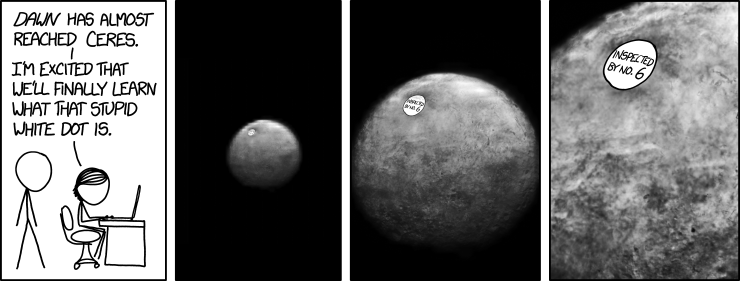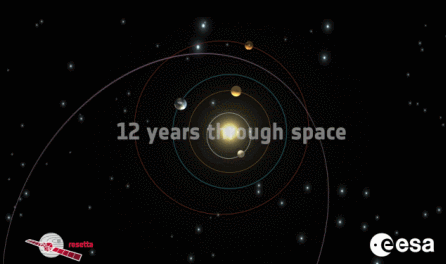
What is Ceres?
Ceres is a dwarf planet that is also the largest asteroid in our Solar System's asteroid belt. It was discovered in 1801 by Giuseppe Piazzi. Originally thought to be a "missing planet" that was proposed to exist between Mars and Jupiter, it wasn't until discoveries of neighboring bodies that the name "asteroid" was adopted and Ceres officially became the first asteroid to be discovered. In 2006, while Pluto was "demoted" to dwarf planet, Ceres got "promoted".
How big is Ceres?

It's huge.... for an asteroid. It comprises a third of the mass of the entire asteroid belt. However, that is still only about 4% the mass of the Moon. The mass is sufficient enough to give it a spherical shape though. The surface area is approximately equal to a third the land area of the US.
What is Ceres composed of?

This is where things get interesting. Ceres consists of a rocky core with an icy mantle. This mantle is estimated to contain 200 million cubic kilometers of water, which is more than the amount of fresh water on Earth. That's a lot of water. Last year, astronomers discovered plumes of water vapors shooting off of the dwarf planet. They don't know what exactly is causing this, but it could be cryovolcanic eruptions. Yes, cryovolcanos exist and they are as awesome as they sound.
This place sounds fascinating. Are there plans to explore it?
Yes! The Dawn space probe is expected to enter orbit of Ceres on March 6th, where it will spend several months orbiting the dwarf planet, mapping its terrain and analyzing its gravity and surface composition. It should tell us a lot about the early Solar System and how planets are formed. This will be the first dwarf planet ever explored by humans.
A week ago, Dawn snapped a few of the highest-resolution photos ever taken of Ceres. They revealed a "white dot", an intriguing surface element that scientists are keen to learn more about. Here is a gif of those images:

Is there a chance of extraterrestrial life on Ceres?
Maybe. As mentioned, there is a LOT of water on Ceres. It's probably all ice, but it is hypothesized that there may be oceans existing under all of that ice. And where there is liquid water, there is the possibility of life. There is also a theory that Ceres may have been an originator of water and/or life on Earth. Due to its low gravity, it's much easier for debris from impacts to escape its orbit and land on Earth.
Either way, this little dwarf planet has a lot of mysteries just waiting to be uncovered. I can't wait to learn more about it.







